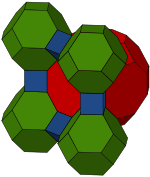Cantitruncated cubic honeycomb
| Cantitruncated cubic honeycomb | |
|---|---|
|
| |
| Type | Uniform honeycomb |
| Schläfli symbol | tr{4,3,4} t0,1,2{4,3,4} |
| Coxeter-Dynkin diagram | |
| Vertex figure |   (Irreg. tetrahedron) |
| Coxeter group | [4,3,4],  |
| Space group Fibrifold notation | Pm3m (221) 4−:2 |
| Dual | triangular pyramidille |
| Properties | vertex-transitive |
The cantitruncated cubic honeycomb is a uniform space-filling tessellation (or honeycomb) in Euclidean 3-space, made up of truncated cuboctahedra, truncated octahedra, and cubes in a ratio of 1:1:3.
John Horton Conway calls this honeycomb a n-tCO-trille, and its dual triangular pyramidille.
Images

Symmetry
Cells can be shown in two different symmetries. The linear Coxeter-Dynkin diagram form can be drawn with one color for each cell type. The bifurcating diagram form can be drawn with two types (colors) of truncated cuboctahedron cells alternating.
| Construction | Cantitruncated cubic | Omnitruncated alternate cubic |
|---|---|---|
| Coxeter group | [4,3,4],  =<[4,31,1]> |
[4,31,1],  |
| Space group | Pm3m (221) | Fm3m (225) |
| Fibrifold | 4−:2 | 2−:2 |
| Coloring |  |
 |
| Coxeter-Dynkin diagram | ||
| Vertex figure |  |
 |
| Vertex figure symmetry |
[ ] order 2 |
[ ]+ order 1 |
Related honeycombs
The [4,3,4], ![]()
![]()
![]()
![]()
![]()
![]()
![]() , Coxeter group generates 15 permutations of uniform tessellations, 9 with distinct geometry including the alternated cubic honeycomb. The expanded cubic honeycomb (also known as the runcinated tesseractic honeycomb) is geometrically identical to the cubic honeycomb.
, Coxeter group generates 15 permutations of uniform tessellations, 9 with distinct geometry including the alternated cubic honeycomb. The expanded cubic honeycomb (also known as the runcinated tesseractic honeycomb) is geometrically identical to the cubic honeycomb.
| Space group |
Fibrifold | Extended symmetry |
Extended diagram |
Order | Honeycombs |
|---|---|---|---|---|---|
| Pm3m (221) |
4−:2 | [4,3,4] | ×1 | ||
| Fm3m (225) |
2−:2 | [1+,4,3,4] = [4,31,1] |
= |
Half | |
| I43m (217) |
4o:2 | [[(4,3,4,2+)]] | Half × 2 | ||
| Fd3m (227) |
2+:2 | [[1+,4,3,4,1+]] = [[3[4]]] |
= |
Quarter × 2 | |
| Im3m (229) |
8o:2 | [[4,3,4]] | ×2 |
The [4,31,1], ![]()
![]()
![]()
![]()
![]() , Coxeter group generates 9 permutations of uniform tessellations, 4 with distinct geometry including the alternated cubic honeycomb.
, Coxeter group generates 9 permutations of uniform tessellations, 4 with distinct geometry including the alternated cubic honeycomb.
| Space group |
Fibrifold | Extended symmetry |
Extended diagram |
Order | Honeycombs |
|---|---|---|---|---|---|
| Fm3m (225) |
2−:2 | [4,31,1] = [4,3,4,1+] |
= |
×1 | |
| Fm3m (225) |
2−:2 | <[1+,4,31,1]> = <[3[4]]> |
= |
×2 | |
| Pm3m (221) |
4−:2 | <[4,31,1]> | ×2 |
Alternation

 This image shows a partial honeycomb of the alternation of the cantitruncated cubic honeycomb. It contains three types of cells: snub cubes, icosahedra (snub tetrahedron), and tetrahedra. In addition the gaps created at the alternated vertices form tetrahedral cells. |
See also
| Wikimedia Commons has media related to Cantitruncated cubic honeycomb. |
References
- John H. Conway, Heidi Burgiel, Chaim Goodman-Strauss, (2008) The Symmetries of Things, ISBN 978-1-56881-220-5 (Chapter 21, Naming the Archimedean and Catalan polyhedra and tilings, Architectonic and Catoptric tessellations, p 292-298, includes all the nonprismatic forms)
- Williams, Robert (1979). The Geometrical Foundation of Natural Structure: A Source Book of Design. Dover Publications, Inc. p. 197. ISBN 0-486-23729-X. Chapter 5 (Polyhedral packing and spacing filling): Fig. 5-13, p.176 shows this honeycomb. Fig. 5-34 shows a partial honeycomb of the alternation with only snub cube cells show.
- George Olshevsky, Uniform Panoploid Tetracombs, Manuscript (2006) (Complete list of 11 convex uniform tilings, 28 convex uniform honeycombs, and 143 convex uniform tetracombs)
- Branko Grünbaum, Uniform tilings of 3-space. Geombinatorics 4(1994), 49 - 56.
- Kaleidoscopes: Selected Writings of H.S.M. Coxeter, edited by F. Arthur Sherk, Peter McMullen, Anthony C. Thompson, Asia Ivic Weiss, Wiley-Interscience Publication, 1995, ISBN 978-0-471-01003-6
- (Paper 22) H.S.M. Coxeter, Regular and Semi Regular Polytopes I, [Math. Zeit. 46 (1940) 380-407, MR 2,10] (1.9 Uniform space-fillings)
- A. Andreini, Sulle reti di poliedri regolari e semiregolari e sulle corrispondenti reti correlative (On the regular and semiregular nets of polyhedra and on the corresponding correlative nets), Mem. Società Italiana della Scienze, Ser.3, 14 (1905) 75–129.
- Richard Klitzing, 3D Euclidean Honeycombs, x4x3x4o - grich - O18
- Uniform Honeycombs in 3-Space: 06-Grich

